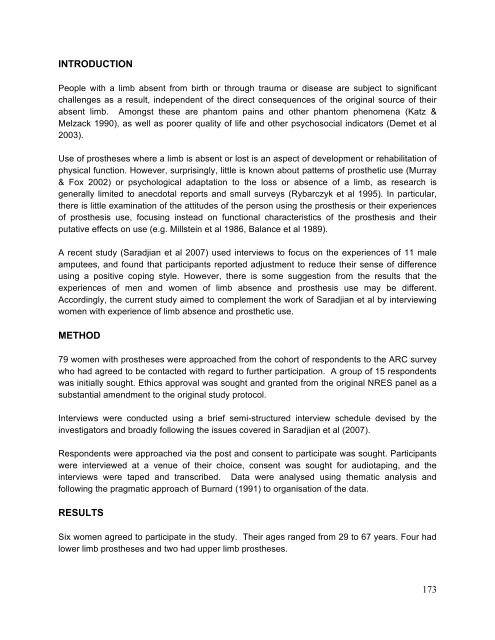Download the report - The Healing Foundation
Download the report - The Healing Foundation
Download the report - The Healing Foundation
Create successful ePaper yourself
Turn your PDF publications into a flip-book with our unique Google optimized e-Paper software.
INTRODUCTION<br />
People with a limb absent from birth or through trauma or disease are subject to significant<br />
challenges as a result, independent of <strong>the</strong> direct consequences of <strong>the</strong> original source of <strong>the</strong>ir<br />
absent limb. Amongst <strong>the</strong>se are phantom pains and o<strong>the</strong>r phantom phenomena (Katz &<br />
Melzack 1990), as well as poorer quality of life and o<strong>the</strong>r psychosocial indicators (Demet et al<br />
2003).<br />
Use of pros<strong>the</strong>ses where a limb is absent or lost is an aspect of development or rehabilitation of<br />
physical function. However, surprisingly, little is known about patterns of pros<strong>the</strong>tic use (Murray<br />
& Fox 2002) or psychological adaptation to <strong>the</strong> loss or absence of a limb, as research is<br />
generally limited to anecdotal <strong>report</strong>s and small surveys (Rybarczyk et al 1995). In particular,<br />
<strong>the</strong>re is little examination of <strong>the</strong> attitudes of <strong>the</strong> person using <strong>the</strong> pros<strong>the</strong>sis or <strong>the</strong>ir experiences<br />
of pros<strong>the</strong>sis use, focusing instead on functional characteristics of <strong>the</strong> pros<strong>the</strong>sis and <strong>the</strong>ir<br />
putative effects on use (e.g. Millstein et al 1986, Balance et al 1989).<br />
A recent study (Saradjian et al 2007) used interviews to focus on <strong>the</strong> experiences of 11 male<br />
amputees, and found that participants <strong>report</strong>ed adjustment to reduce <strong>the</strong>ir sense of difference<br />
using a positive coping style. However, <strong>the</strong>re is some suggestion from <strong>the</strong> results that <strong>the</strong><br />
experiences of men and women of limb absence and pros<strong>the</strong>sis use may be different.<br />
Accordingly, <strong>the</strong> current study aimed to complement <strong>the</strong> work of Saradjian et al by interviewing<br />
women with experience of limb absence and pros<strong>the</strong>tic use.<br />
METHOD<br />
79 women with pros<strong>the</strong>ses were approached from <strong>the</strong> cohort of respondents to <strong>the</strong> ARC survey<br />
who had agreed to be contacted with regard to fur<strong>the</strong>r participation. A group of 15 respondents<br />
was initially sought. Ethics approval was sought and granted from <strong>the</strong> original NRES panel as a<br />
substantial amendment to <strong>the</strong> original study protocol.<br />
Interviews were conducted using a brief semi-structured interview schedule devised by <strong>the</strong><br />
investigators and broadly following <strong>the</strong> issues covered in Saradjian et al (2007).<br />
Respondents were approached via <strong>the</strong> post and consent to participate was sought. Participants<br />
were interviewed at a venue of <strong>the</strong>ir choice, consent was sought for audiotaping, and <strong>the</strong><br />
interviews were taped and transcribed. Data were analysed using <strong>the</strong>matic analysis and<br />
following <strong>the</strong> pragmatic approach of Burnard (1991) to organisation of <strong>the</strong> data.<br />
RESULTS<br />
Six women agreed to participate in <strong>the</strong> study. <strong>The</strong>ir ages ranged from 29 to 67 years. Four had<br />
lower limb pros<strong>the</strong>ses and two had upper limb pros<strong>the</strong>ses.<br />
173


